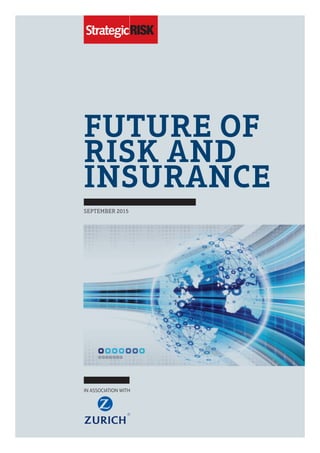This document provides an overview of the future of risk and insurance. It highlights 10 key insights and trends, including the need to disrupt and innovate before others do, embrace technological change, get certified in risk management, leverage mobile technology, mentor the next generation, question traditional underwriting practices, and think globally about risk in our interconnected world. Emerging technologies like 3D printing, artificial intelligence, and messaging apps are disrupting traditional business models, and the insurance industry must adapt to better understand and manage emerging risks.






![7
Future of risk and insurance
www.strategic-risk-global.com |
EMERGING RISK
cyber challenges
Search for the key to
cyber cover continues
I
n July, a Jeep Cherokee was hacked by
cyber experts as part of a stunt set up with
Wired magazine. They took remote
control of its radio, air conditioning,
windshield and transmission system through
the vehicle’s internet-enabled entertainment
system. The incident led Fiat Chrysler to recall
1.4 million Jeeps.
Could damage to the Jeep Cherokee or Fiat
Chrysler brands have been covered by a cyber
policy for this security breach? Or perhaps a
product liability policy would have covered
the cost of the recall? These are typical of the
questions vexing risk managers and insurers
on how to handle emerging technology risks,
including data security and reputation risks.
“The whole issue of cyber risk, the
technology- and digital-driven transformation
of every part of the economy, means that you
cannot separate cyber [risk as a standalone
threat]” says Sarah Stephens, JLT Speciality’s
head of cyber, technology, and media errors
and omissions. “There are so many loss
scenarios that could be triggered by a
technology failure, a security failure, a cyber
or quasi-cyber incident, that could be, or
should be, covered in a property or casualty
policy. That is a massive challenge for insurers
and for the industry right now.”
In some cases, organisations are taking
matters into their own hands and finding their
own ways to mitigate cyber exposures. In
response to risks around its customer data,
With the enormity of the risk still holding back insurers and a lack of clarity
among buyers, debate is still raging about how to handle cyber risk](https://image.slidesharecdn.com/8241af58-e25e-4f79-8821-964587ebdc69-160707113527/85/FutureOfRiskAndInsurance-7-320.jpg)








